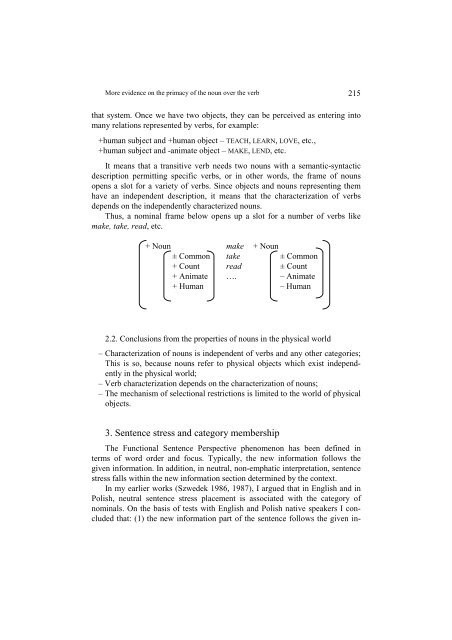s - Wyższa SzkoÅa Filologiczna we WrocÅawiu
s - Wyższa SzkoÅa Filologiczna we WrocÅawiu
s - Wyższa SzkoÅa Filologiczna we WrocÅawiu
You also want an ePaper? Increase the reach of your titles
YUMPU automatically turns print PDFs into web optimized ePapers that Google loves.
More evidence on the primacy of the noun over the verb 215<br />
that system. Once <strong>we</strong> have two objects, they can be perceived as entering into<br />
many relations represented by verbs, for example:<br />
+human subject and +human object – TEACH, LEARN, LOVE, etc.,<br />
+human subject and -animate object – MAKE, LEND, etc.<br />
It means that a transitive verb needs two nouns with a semantic-syntactic<br />
description permitting specific verbs, or in other words, the frame of nouns<br />
opens a slot for a variety of verbs. Since objects and nouns representing them<br />
have an independent description, it means that the characterization of verbs<br />
depends on the independently characterized nouns.<br />
Thus, a nominal frame below opens up a slot for a number of verbs like<br />
make, take, read, etc.<br />
+ Noun make + Noun<br />
± Common take ± Common<br />
+ Count read ± Count<br />
+ Animate …. – Animate<br />
+ Human – Human<br />
2.2. Conclusions from the properties of nouns in the physical world<br />
– Characterization of nouns is independent of verbs and any other categories;<br />
This is so, because nouns refer to physical objects which exist independently<br />
in the physical world;<br />
– Verb characterization depends on the characterization of nouns;<br />
– The mechanism of selectional restrictions is limited to the world of physical<br />
objects.<br />
3. Sentence stress and category membership<br />
The Functional Sentence Perspective phenomenon has been defined in<br />
terms of word order and focus. Typically, the new information follows the<br />
given information. In addition, in neutral, non-emphatic interpretation, sentence<br />
stress falls within the new information section determined by the context.<br />
In my earlier works (Sz<strong>we</strong>dek 1986, 1987), I argued that in English and in<br />
Polish, neutral sentence stress placement is associated with the category of<br />
nominals. On the basis of tests with English and Polish native speakers I concluded<br />
that: (1) the new information part of the sentence follows the given in-
















